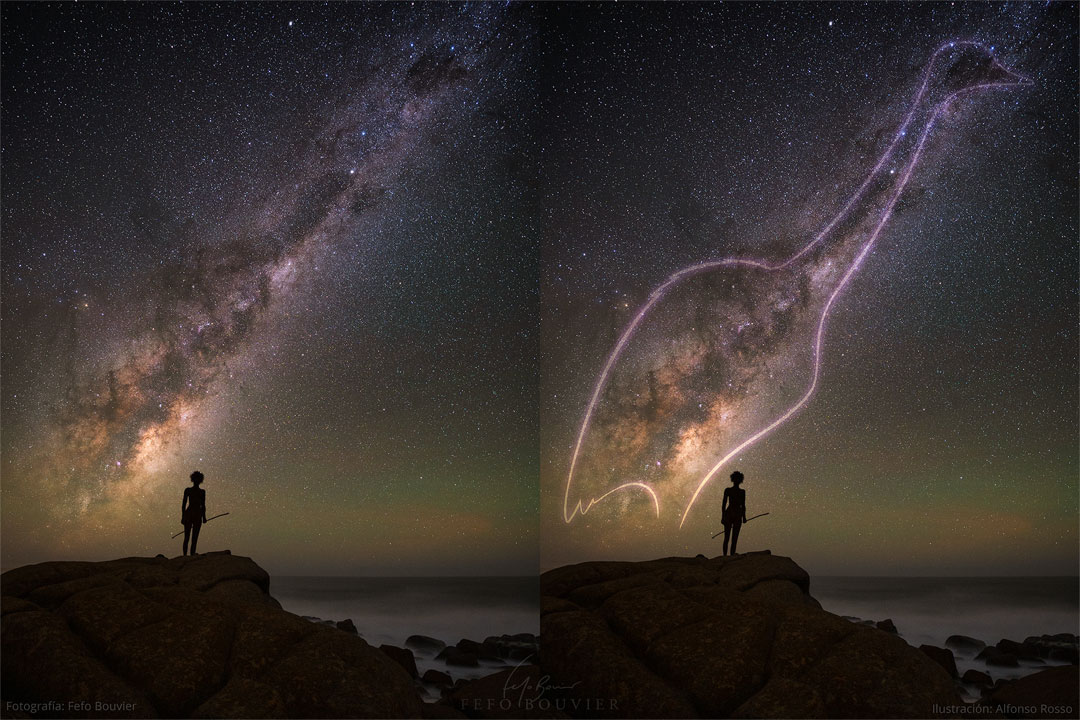20. June 2023
銀河內底 ê 美洲鴕鳥

探索宇宙1!逐工會揀一幅無仝款 ê 影像抑是相片,𤆬你熟似咱這个迷人 ê 宇宙,閣有專業天文學者2為你3解說4。
- 原始文章:The Ñandú in the Milky Way
- 影像來源 kah 版權:Fefo Bouvier; 畫線 ê 人:Alfonso Rosso
- 台文翻譯:An-Li Tsai (NCU)
[漢羅] 銀河內底 ê 美洲鴕鳥
你敢捌看過銀河內底 ê 鳥仔? 毋但 月娘頂懸有藏一个查埔人,咱 ê 夜空閣有足濟故事通講。 而且無仝所在 較有歷史 ê 文化,嘛會 kā in 上久長 ê 傳說 投影 tī 天頂 ê 天星抑是星雲。 一代一代 ê 人看這寡天象,聽 in ê 故事,就會繼續 kā 故事傳落去。 這張相片 毋但是 銀河系 中央帶 ê 一部份爾爾, 若是根據幾若个 烏拉圭 原住民 ê 傳說,in 閣是一隻叫做 美洲鴕鳥 ê 大隻鳥仔。 而且,美洲鴕鳥 ê 跤跡閣 kah 南十字 星群有關係。 前景 ê 剪影 是 María Micaela Guyunusa ê 雕像。 伊是活 tī 1800 年代 Charrúa 族 ê 原住民查某,是一个抵抗殖民 ê 象徵。 這張組合影像是 4 月中 tī 烏拉圭 Cabo Polonio 翕--ê,背景是 大西洋。
[POJ] Gî-hô lāi-té ê Bí-chiu-tô-chiáu
Lí kám bat khòaⁿ-kòe Gî-hô lāi-té ê chiáu-á? M̄-nā goe̍h-niû téng-koân ū chhàng chi̍t-ê cha-po͘-lâng, lán ê iā-khong koh-ū chiok chē kò͘-sū thang kóng. Jî-chhiáⁿ bô-kâng só͘-chāi khah ū le̍k-sú ê bûn-hòa, mā ē kā in siōng kú-tn̂g ê thoân-soat tâu-iáⁿ tī thiⁿ-téng ê thiⁿ-chheⁿ ia̍h-sī chheⁿ hûn. Chi̍t-tāi chi̍t-tāi ê lâng khòaⁿ chit-kóa thian-siòng, thiaⁿ in ê kò͘-sū, to̍h ē kè-sio̍k kā kò͘-sū thoân--lo̍h-khì. Chit-tiuⁿ siòng-phìⁿ m̄ tān-sī Gî-hô-hē tiong-ng-tòa ê chi̍t-pō͘-hūn niā-niā, nā-sī kin-kì kúi-nā-ê O͘-la-kui goân-chū-bîn ê thoân-soat, in koh sī chi̍t-chiah kiò-chò Bí-chiu-tô-chiáu ê tōa-chiah chiáu-á. Jî-chhiáⁿ, Bí-chiu-tô-chiáu ê kha-jiah koh kah Lâm-si̍p-jī seng-kûn ū koan-hē. Chiân-kéng ê chián iáⁿ sī María Micaela Guyunusa ê tiau-siōng. I sī oa̍h tī 1800 nî-tāi Charrúa cho̍k ê goân-chū-bîn cha-bó͘ ,sī chi̍t-ê tí-khòng si̍t-bîn ê siōng-teng. Chit-tiuⁿ cho͘-ha̍p iáⁿ-siōng sī 4 ge̍h-tiong tī O͘-la-kui Cabo Polonio hip--ê, pōe-kéng sī Tāi-se-iûⁿ.
[KIP] Gî-hô lāi-té ê Bí-tsiu-tô-tsiáu
Lí kám bat khuànn-kuè Gî-hô lāi-té ê tsiáu-á? M̄-nā gue̍h-niû tíng-kuân ū tshàng tsi̍t-ê tsa-poo-lâng, lán ê iā-khong koh-ū tsiok tsē kòo-sū thang kóng. Jî-tshiánn bô-kâng sóo-tsāi khah ū li̍k-sú ê bûn-huà, mā ē kā in siōng kú-tn̂g ê thuân-suat tâu-iánn tī thinn-tíng ê thinn-tshenn ia̍h-sī tshenn hûn. Tsi̍t-tāi tsi̍t-tāi ê lâng khuànn tsit-kuá thian-siòng, thiann in ê kòo-sū, to̍h ē kè-sio̍k kā kòo-sū thuân--lo̍h-khì. Tsit-tiunn siòng-phìnn m̄ tān-sī Gî-hô-hē tiong-ng-tuà ê tsi̍t-pōo-hūn niā-niā, nā-sī kin-kì kuí-nā-ê Oo-la-kui guân-tsū-bîn ê thuân-suat, in koh sī tsi̍t-tsiah kiò-tsò Bí-tsiu-tô-tsiáu ê tuā-tsiah tsiáu-á. Jî-tshiánn, Bí-tsiu-tô-tsiáu ê kha-jiah koh kah Lâm-si̍p-jī sing-kûn ū kuan-hē. Tsiân-kíng ê tsián iánn sī María Micaela Guyunusa ê tiau-siōng. I sī ua̍h tī 1800 nî-tāi Charrúa tso̍k ê guân-tsū-bîn tsa-bóo ,sī tsi̍t-ê tí-khòng si̍t-bîn ê siōng-ting. Tsit-tiunn tsoo-ha̍p iánn-siōng sī 4 ge̍h-tiong tī Oo-la-kui Cabo Polonio hip--ê, puē-kíng sī Tāi-se-iûnn.
[English] The Ñandú in the Milky Way
Have you seen the bird in the Milky Way? Beyond the man in the Moon, the night sky is filled with stories, and cultures throughout history have projected some of their most enduring legends onto the stars and dust above. Generations of people see these celestial icons, hear their associated stories, and pass them down. Pictured here is not only a segment of the central band of our Milky Way galaxy, but, according to folklore of several native peoples of Uruguay, the outline of a great bird called Ñandú. Furthermore, Ñandú's footprint is associated with the Southern Cross asterism. In the foreground, in silhouette, is a statue of María Micaela Guyunusa, an indigenous woman of the Charrúa people who lived in the 1800s and endures as a symbol of colonial resistance. The composite image was taken in mid-April in Cabo Polonio, Uruguay, with the Atlantic Ocean in the background.
詞彙學習
| 漢羅 | POJ | KIP | 華語 | English |
|---|---|---|---|---|
| 銀河系 | Gîn-hô-hē | Gîn-hô-hē | 銀河系 | Milky Way galaxy |
| 中央帶 | tiong-ng-tòa | tiong-ng-tuà | 中央帶 | central band |
| 美洲鴕鳥 | Bí-chiu-tô-chiáu | Bí-tsiu-tô-tsiáu | 美洲鴕鳥 | Ñandú |
| 南十字 | Lâm-si̍p-jī | Lâm-si̍p-jī | 南十字 | Southern Cross |
| 星群 | seng-kûn | sing-kûn | 星群 | asterism |
| 烏拉圭 | O͘-la-kui | Oo-la-kui | 烏拉圭 | Uruguay |